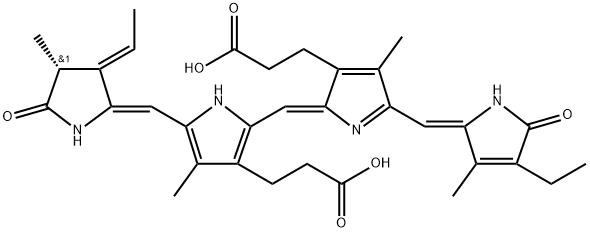All AbMole products are for research use only, cannot be used for human consumption.

For this product's availability, delivery time and price, please email [email protected] directly or click the "Inquiry Now" button below.
Phycocyanobilin is an effective scavenger for various reactive oxygen species. Phycocyanobilin can be used for the research of Alzheimer’s disease. Its cell-protective mechanisms include the reduction of oxidative stress damage, which may contribute to its efficacy in the study of neurodegenerative diseases.

Gene. 2025 Apr 04;957:149465.
Uncovering the therapeutic potentials of marine-derived natural compounds with small amounts for neurological disorders
Phycocyanobilin purchased from AbMole
| Molecular Weight | 586.69 |
| Formula | C33H38N4O6 |
| CAS Number | 20298-86-6 |
| Solubility (25°C) | Soluble in Water/PBS after breaking the cell wall using ultrasonic cell disruptor |
| Storage | -20°C, protect from light, sealed |
[1] Runze Liu, et al. Biomed Pharmacother. Phycocyanin: Anti-inflammatory effect and mechanism
[3] Yi Li. J Immunol Res. The Bioactivities of Phycocyanobilin from Spirulina
| Related ROS Products |
|---|
| Cyanidin
Cyanidin is an antioxidant compound extracted from plants. It scavenges free radicals, inhibits xanthine oxidase activity, and protects DNA from cleavage. |
| N-Acetyl-L-cysteine ethyl ester
N-Acetyl-L-cysteine ethyl ester exhibits enhanced cell permeability, and produce NAC and cysteine. N-Acetyl-L-cysteine ethyl ester increases circulating hydrogen sulfide (H2S) and can be used as an H2S producer. |
| Manganese(salen) chloride
Manganese(salen) chloride (EUK-8) is a superoxide dismutase and catalase mimetic, it is an antioxidant with oxyradical scavenging properties. |
| Magnoloside F
Magnoloside F is a natural compound that can be isolated from the Magnolia officinalis, and has antioxidant activity. |
| Porphyra 334
Porphyra 334 is an antioxidative and anti-photoaging agent. |
All AbMole products are for research use only, cannot be used for human consumption or veterinary use. We do not provide products or services to individuals. Please comply with the intended use and do not use AbMole products for any other purpose.


Products are for research use only. Not for human use. We do not sell to patients.
© Copyright 2010-2024 AbMole BioScience. All Rights Reserved.
